Acoustic Emission and Deep Learning for the Classification of the Mechanical Behavior of AlSi10Mg AM-SLM Specimens
Abstract
1. Introduction
2. Materials and Methods
2.1. Materials and Testing
2.2. Continuous Wavelet Transform Based on Acoustic Emission Signals
2.3. Deep Convolutional Neural Network
3. Results and Discussions
3.1. Tensile Test Results
3.2. Damage Characterization Using the CWT of AE Signals
3.3. Damage Classification Using the Deep Learning Approach
3.3.1. Classification of AE Signals Based on the Damages Stage
3.3.2. Classification of AE Signals Based on the Configuration of the Specimen
3.3.3. Classification of AE Signals from Individual Specimens
4. Conclusions
Author Contributions
Funding
Institutional Review Board Statement
Informed Consent Statement
Data Availability Statement
Conflicts of Interest
References
- Zhao, L.; Santos Macías, J.G.; Ding, L.; Idrissi, H.; Simar, A. Damage Mechanisms in Selective Laser Melted AlSi10Mg under as Built and Different Post-Treatment Conditions. Mater. Sci. Eng. A 2019, 764, 138210. [Google Scholar] [CrossRef]
- Uhlmann, E.; Kersting, R.; Klein, T.B.; Cruz, M.F.; Borille, A.V. Additive Manufacturing of Titanium Alloy for Aircraft Components. Procedia CIRP 2015, 35, 55–60. [Google Scholar] [CrossRef]
- Yadroitsev, I.; Krakhmalev, P.; Yadroitsava, I. Selective Laser Melting of Ti6Al4V Alloy for Biomedical Applications: Temperature Monitoring and Microstructural Evolution. J. Alloys Compd. 2014, 583, 404–409. [Google Scholar] [CrossRef]
- Singh, S.; Ramakrishna, S.; Singh, R. Material Issues in Additive Manufacturing: A Review. J. Manuf. Process. 2017, 25, 185–200. [Google Scholar] [CrossRef]
- Ngo, T.D.; Kashani, A.; Imbalzano, G.; Nguyen, K.T.Q.; Hui, D. Additive Manufacturing (3D Printing): A Review of Materials, Methods, Applications and Challenges. Compos. B Eng. 2018, 143, 172–196. [Google Scholar] [CrossRef]
- Barile, C.; Casavola, C.; Moramarco, V.; Vimalathithan, P.K. A Comprehensive Study of Mechanical and Acoustic Properties of Selective Laser Melting Material. Arch. Civ. Mech. Eng. 2019, 1, 3. [Google Scholar] [CrossRef]
- Gu, D.; Wang, Z.; Shen, Y.; Li, Q.; Li, Y. In-Situ TiC Particle Reinforced Ti–Al Matrix Composites: Powder Preparation by Mechanical Alloying and Selective Laser Melting Behavior. Appl. Surf. Sci. 2009, 255, 9230–9240. [Google Scholar] [CrossRef]
- Amato, K.N.; Gaytan, S.M.; Murr, L.E.; Martinez, E.; Shindo, P.W.; Hernandez, J.; Collins, S.; Medina, F. Microstructures and Mechanical Behavior of Inconel 718 Fabricated by Selective Laser Melting. Acta Mater. 2012, 60, 2229–2239. [Google Scholar] [CrossRef]
- Geiger, F.; Kunze, K.; Etter, T. Tailoring the Texture of IN738LC Processed by Selective Laser Melting (SLM) by Specific Scanning Strategies. Mater. Sci. Eng. A 2016, 661, 240–246. [Google Scholar] [CrossRef]
- Ma, M.; Wang, Z.; Zeng, X. A Comparison on Metallurgical Behaviors of 316L Stainless Steel by Selective Laser Melting and Laser Cladding Deposition. Mater. Sci. Eng. A 2017, 685, 265–273. [Google Scholar] [CrossRef]
- Wang, D.; Song, C.; Yang, Y.; Bai, Y. Investigation of Crystal Growth Mechanism during Selective Laser Melting and Mechanical Property Characterization of 316L Stainless Steel Parts. Mater. Des. 2016, 100, 291–299. [Google Scholar] [CrossRef]
- Rao, H.; Giet, S.; Yang, K.; Wu, X.; Davies, C.H.J. The Influence of Processing Parameters on Aluminium Alloy A357 Manufactured by Selective Laser Melting. Mater. Des. 2016, 109, 334–346. [Google Scholar] [CrossRef]
- Wu, J.; Wang, X.Q.; Wang, W.; Attallah, M.M.; Loretto, M.H. Microstructure and Strength of Selectively Laser Melted AlSi10Mg. Acta Mater. 2016, 117, 311–320. [Google Scholar] [CrossRef]
- Aversa, A.; Lorusso, M.; Cattano, G.; Manfredi, D.; Calignano, F.; Ambrosio, E.P.; Biamino, S.; Fino, P.; Lombardi, M.; Pavese, M. A Study of the Microstructure and the Mechanical Properties of an AlSiNi Alloy Produced via Selective Laser Melting. J. Alloys Compd. 2017, 695, 1470–1478. [Google Scholar] [CrossRef]
- Gupta, A.K.; Lloyd, D.J.; Court, S.A. Precipitation Hardening in Al-Mg-Si Alloys with and without Excess Si. Mater. Sci. Eng. A 2001, 316, 11–17. [Google Scholar] [CrossRef]
- Thijs, L.; Kempen, K.; Kruth, J.P.; van Humbeeck, J. Fine-Structured Aluminium Products with Controllable Texture by Selective Laser Melting of Pre-Alloyed AlSi10Mg Powder. Acta Mater. 2013, 61, 1809–1819. [Google Scholar] [CrossRef]
- Kempen, K.; Thijs, L.; van Humbeeck, J.; Kruth, J.P. Mechanical Properties of AlSi10Mg Produced by Selective Laser Melting. Phys. Procedia 2012, 39, 439–446. [Google Scholar] [CrossRef]
- Patakham, U.; Palasay, A.; Wila, P.; Tongsri, R. MPB Characteristics and Si Morphologies on Mechanical Properties and Fracture Behavior of SLM AlSi10Mg. Mater. Sci. Eng. A 2021, 821, 141602. [Google Scholar] [CrossRef]
- Dong, Z.; Liu, Y.; Li, W.; Liang, J. Orientation Dependency for Microstructure, Geometric Accuracy and Mechanical Properties of Selective Laser Melting AlSi10Mg Lattices. J. Alloys Compd. 2019, 791, 490–500. [Google Scholar] [CrossRef]
- Maconachie, T.; Leary, M.; Zhang, J.; Medvedev, A.; Sarker, A.; Ruan, D.; Lu, G.; Faruque, O.; Brandt, M. Effect of Build Orientation on the Quasi-Static and Dynamic Response of SLM AlSi10Mg. Mater. Sci. Eng. A 2020, 788, 139445. [Google Scholar] [CrossRef]
- Kok, Y.; Tan, X.P.; Wang, P.; Nai, M.L.S.; Loh, N.H.; Liu, E.; Tor, S.B. Anisotropy and Heterogeneity of Microstructure and Mechanical Properties in Metal Additive Manufacturing: A Critical Review. Mater. Des. 2018, 139, 565–586. [Google Scholar] [CrossRef]
- Beretta, S.; Gargourimotlagh, M.; Foletti, S.; du Plessis, A.; Riccio, M. Fatigue Strength Assessment of “as Built” AlSi10Mg Manufactured by SLM with Different Build Orientations. Int. J. Fatigue 2020, 139, 105737. [Google Scholar] [CrossRef]
- Tetelman, A.; Chow, R. Acoustic Emission Testing and Microfracture Processes. Undefined 1971, 30, 30–40. [Google Scholar] [CrossRef]
- Grosse, C.U.; Ohtsu, M.; Aggelis, D.G.; Shiotani, T. (Eds.) Acoustic Emission Testing; Springer Nature: Berlin, Germany, 2022. [Google Scholar] [CrossRef]
- Ito, K.; Kusano, M.; Demura, M.; Watanabe, M. Detection and Location of Microdefects during Selective Laser Melting by Wireless Acoustic Emission Measurement. Addit. Manuf. 2021, 40, 101915. [Google Scholar] [CrossRef]
- Barile, C.; Casavola, C.; Pappalettera, G.; Kannan, V.P.; Renna, G. Acoustic Emission Signal Processing for the Assessment of Corrosion Behaviour in Additively Manufactured AlSi10Mg. Mech. Mater. 2022, 170, 104347. [Google Scholar] [CrossRef]
- Barile, C.; Casavola, C.; Pappalettera, G.; Vimalathithan, P.K. Acoustic Emission Descriptors for the Mechanical Behavior of Selective Laser Melted Samples: An Innovative Approach. Mech. Mater. 2020, 148, 103448. [Google Scholar] [CrossRef]
- Ould Amer, A.; Gloanec, A.L.; Courtin, S.; Touze, C. Characterization of Fatigue Damage in 304L Steel by an Acoustic Emission Method. Procedia Eng. 2013, 66, 651–660. [Google Scholar] [CrossRef]
- Barile, C.; Casavola, C.; Cazzato, A. Materials Acoustic Emissions in 3D Printed Parts under Mode I Delamination Test. Materials 2018, 11, 1760. [Google Scholar] [CrossRef]
- Barile, C.; Casavola, C.; Pappalettera, G.; Pappalettere, C. Fatigue Damage Monitoring by Means of Acoustic Emission and Thermography in Ti Grade 5 Specimens. Procedia Eng. 2015, 114, 487–492. [Google Scholar] [CrossRef]
- Venkatesan, R.; Li, B. Convolutional Neural Networks in Visual Computing: A Concise Guide; CRC Press: Boca Raton, FL, USA, 2017; 186p. [Google Scholar] [CrossRef]
- Ramasamy, P.; Sampathkumar, S. Prediction of Impact Damage Tolerance of Drop Impacted WGFRP Composite by Artificial Neural Network Using Acoustic Emission Parameters. Compos. B Eng. 2014, 60, 457–462. [Google Scholar] [CrossRef]
- Lu, D.; Yu, W. Predicting the Tensile Strength of Single Wool Fibers Using Artificial Neural Network and Multiple Linear Regression Models Based on Acoustic Emission. Text. Res. J. 2020, 91, 533–542. [Google Scholar] [CrossRef]
- Suresh Kumar, C.; Arumugam, V.; Sengottuvelusamy, R.; Srinivasan, S.; Dhakal, H.N. Failure Strength Prediction of Glass/Epoxy Composite Laminates from Acoustic Emission Parameters Using Artificial Neural Network. Appl. Acoust. 2017, 115, 32–41. [Google Scholar] [CrossRef]
- Krishnamoorthy, K.; Sasikumar, T. ANN-Based Prediction of Ultimate Strength of Carbon/Epoxy Tensile Specimen Using Acoustic Emission RMS Data. Int. J. Mater. Prod. Technol. 2016, 53, 61–70. [Google Scholar] [CrossRef]
- Xu, D.; Liu, P.F.; Chen, Z.P. A Deep Learning Method for Damage Prognostics of Fiber-Reinforced Composite Laminates Using Acoustic Emission. Eng. Fract. Mech. 2022, 259, 108139. [Google Scholar] [CrossRef]
- D’Addona, D.; Teti, R.; Caprino, G. Residual Strength Prediction of Artificially Damaged Composite Laminates Based on Neural Networks. J. Intell. Fuzzy Syst. 2012, 23, 217–223. [Google Scholar] [CrossRef]
- Ucar, F.; Korkmaz, D. COVIDiagnosis-Net: Deep Bayes-SqueezeNet Based Diagnosis of the Coronavirus Disease 2019 (COVID-19) from X-Ray Images. Med. Hypotheses 2020, 140, 109761. [Google Scholar] [CrossRef]
- Xu, Y.; Li, Z.; Wang, S.; Li, W.; Sarkodie-Gyan, T.; Feng, S. A Hybrid Deep-Learning Model for Fault Diagnosis of Rolling Bearings. Measurement 2021, 169, 108502. [Google Scholar] [CrossRef]
- Dhar, P.; Dutta, S.; Mukherjee, V. Cross-Wavelet Assisted Convolution Neural Network (AlexNet) Approach for Phonocardiogram Signals Classification. Biomed. Signal Process. Control 2021, 63, 102142. [Google Scholar] [CrossRef]
- Zhang, R.; Yan, X.; Guo, L. Deep Learning-Based Classification of Damage-Induced Acoustic Emission Signals in UHPC. Constr. Build Mater. 2022, 356, 129285. [Google Scholar] [CrossRef]
- Han, G.; Kim, Y.M.; Kim, H.; Oh, T.M.; Song, K.I.; Kim, A.; Kim, Y.; Cho, Y.; Kwon, T.H. Auto-Detection of Acoustic Emission Signals from Cracking of Concrete Structures Using Convolutional Neural Networks: Upscaling from Specimen. Expert Syst. Appl. 2021, 186, 115863. [Google Scholar] [CrossRef]
- Sikdar, S.; Liu, D.; Kundu, A. Acoustic Emission Data Based Deep Learning Approach for Classification and Detection of Damage-Sources in a Composite Panel. Compos. B Eng. 2022, 228, 109450. [Google Scholar] [CrossRef]
- Barile, C.; Casavola, C.; Pappalettera, G.; Paramsamy Kannan, V. Damage Monitoring of Carbon Fibre Reinforced Polymer Composites Using Acoustic Emission Technique and Deep Learning. Compos. Struct. 2022, 292, 115629. [Google Scholar] [CrossRef]
- Continuous Wavelet Transforms—MATLAB & Simulink—MathWorks Italia. Available online: https://it.mathworks.com/help/wavelet/continuous-wavelet-transforms.html?searchHighlight=Continuous%20Wavelet%20Transform%20&s_tid=srchtitle_Continuous%20Wavelet%20Transform%20_1 (accessed on 26 October 2022).
- Grabowska, J.; Palacz, M.; Krawczuk, M. Damage Identification by Wavelet Analysis. Mech. Syst. Signal Process. 2008, 22, 1623–1635. [Google Scholar] [CrossRef]
- Li, Y.; Xu, F. Structural Damage Monitoring for Metallic Panels Based on Acoustic Emission and Adaptive Improvement Variational Mode Decomposition–Wavelet Packet Transform. Struct. Health Monit. 2021, 21, 710–730. [Google Scholar] [CrossRef]
- Burud, N.; Kishen, J.C. Damage Detection Using Wavelet Entropy of Acoustic Emission Waveforms in Concrete under Flexure. Struct. Health Monit. 2020, 20, 1–15. [Google Scholar] [CrossRef]
- Baccar, D.; Söffker, D. Wear Detection by Means of Wavelet-Based Acoustic Emission Analysis. Mech. Syst. Signal Process. 2015, 60–61, 198–207. [Google Scholar] [CrossRef]
- Gao, R.X.; Yan, R. Continuous Wavelet Transform. In Wavelets; Springer: Boston, MA, USA, 2011; pp. 33–48. [Google Scholar] [CrossRef]
- Lee, H.-J.; Kim, K.-T.; Park, J.-H.; Bere, G.; Ochoa, J.J.; Kim, T. Convolutional Neural Network-Based False Battery Data Detection and Classification for Battery Energy Storage Systems. IEEE Trans. Energy Convers. 2021, 36, 3108–3117. [Google Scholar] [CrossRef]
- Beikmohammadi, A.; Faez, K.; Motallebi, A. SWP-LeafNET: A Novel Multistage Approach for Plant Leaf Identification Based on Deep CNN. Expert Syst. Appl. 2022, 202, 117470. [Google Scholar] [CrossRef]
- Gayathri, J.L.; Abraham, B.; Sujarani, M.S.; Nair, M.S. A Computer-Aided Diagnosis System for the Classification of COVID-19 and Non-COVID-19 Pneumonia on Chest X-Ray Images by Integrating CNN with Sparse Autoencoder and Feed Forward Neural Network. Comput. Biol. Med. 2022, 141, 105134. [Google Scholar] [CrossRef]
- Simonyan, K.; Zisserman, A. Very deep convolutional networks for large-scale image recognition. arXiv 2014, arXiv:1409.1556. [Google Scholar]
- Shanthi, T.; Sabeenian, R.S. Modified Alexnet Architecture for Classification of Diabetic Retinopathy Images. Comput. Electr. Eng. 2019, 76, 56–64. [Google Scholar] [CrossRef]
- Iandola, F.N.; Han, S.; Moskewicz, M.W.; Ashraf, K.; Dally, W.J.; Keutzer, K. SqueezeNet: AlexNet-level accuracy with 50x fewer parameters and <0.5 MB model size. arXiv 2016, arXiv:1602.07360. [Google Scholar]
- Krizhevsky, A.; Sutskever, I.; Hinton, G.E. Imagenet classification with deep convolutional neural networks. Commun. ACM 2017, 60, 84–90. [Google Scholar] [CrossRef]
- Setiawan, W.; Ghofur, A.; Hastarita Rachman, F.; Rulaningtyas, R. Deep Convolutional Neural Network AlexNet and Squeezenet for Maize Leaf Diseases Image Classification. Kinet. Game Technol. Inf. Syst. Comput. Netw. Comput. Electron. Control. 2021, 6. [Google Scholar] [CrossRef]
- Siddique, S.; Imran, M.; Rauer, M.; Kaloudis, M.; Wycisk, E.; Emmelmann, C.; Walther, F. Computed Tomography for Characterization of Fatigue Performance of Selective Laser Melted Parts. Mater. Des. 2015, 83, 661–669. [Google Scholar] [CrossRef]
- Awd, M.; Siddique, S.; Johannsen, J.; Emmelmann, C.; Walther, F. Very High-Cycle Fatigue Properties and Microstructural Damage Mechanisms of Selective Laser Melted AlSi10Mg Alloy. Int. J. Fatigue 2019, 124, 55–69. [Google Scholar] [CrossRef]
- Yao, Y.; Wang, K.; Wang, X.; Li, L.; Cai, W.; Kelly, S.; Esparragoza, N.; Rosser, M.; Yan, F. Microstructural Heterogeneity and Mechanical Anisotropy of 18Ni-330 Maraging Steel Fabricated by Selective Laser Melting: The Effect of Build Orientation and Height. J. Mater. Res. 2020, 35, 2065–2076. [Google Scholar] [CrossRef]
- Oostwal, E.; Straat, M.; Biehl, M. Hidden Unit Specialization in Layered Neural Networks: ReLU vs. Sigmoidal Activation. Phys. A Stat. Mech. Its Appl. 2021, 564, 125517. [Google Scholar] [CrossRef]
- Islam, M.A.; Wimmer, H.; Rebman, C.M. Examining Sigmoid vs ReLu Activation Functions in Deep Learning. In Interdisciplinary Research in Technology and Management; CRC Press: Boca Raton, FL, USA, 2021; pp. 432–437. [Google Scholar] [CrossRef]




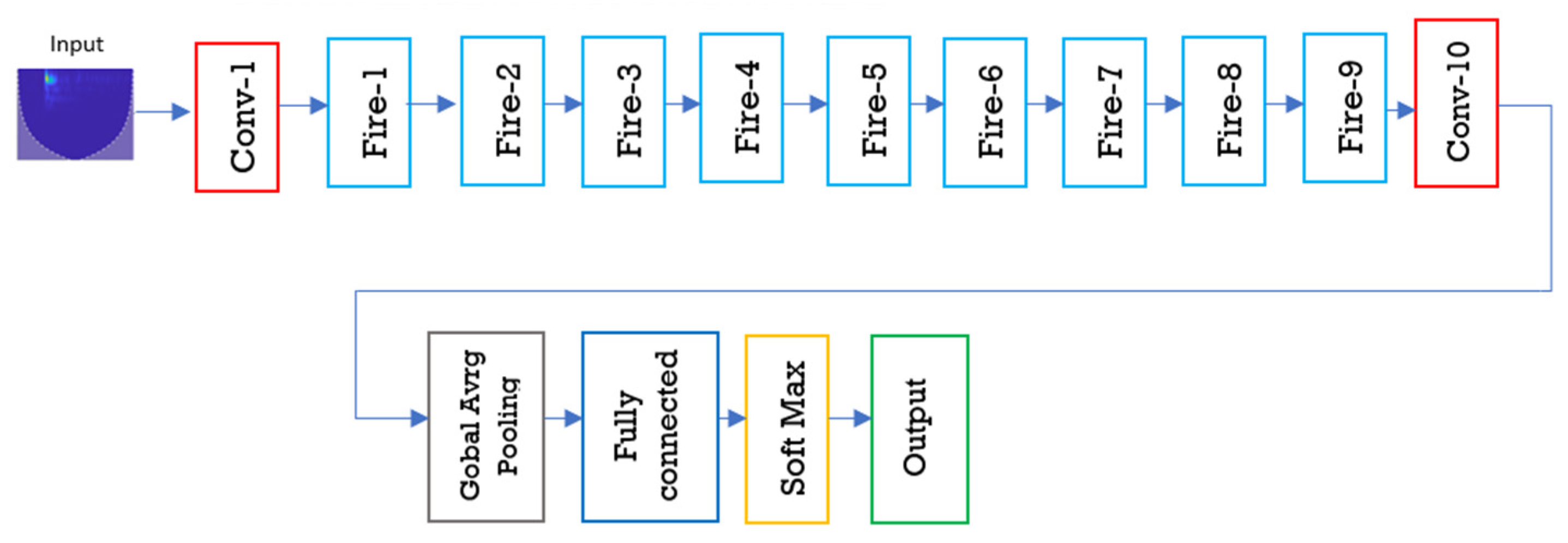
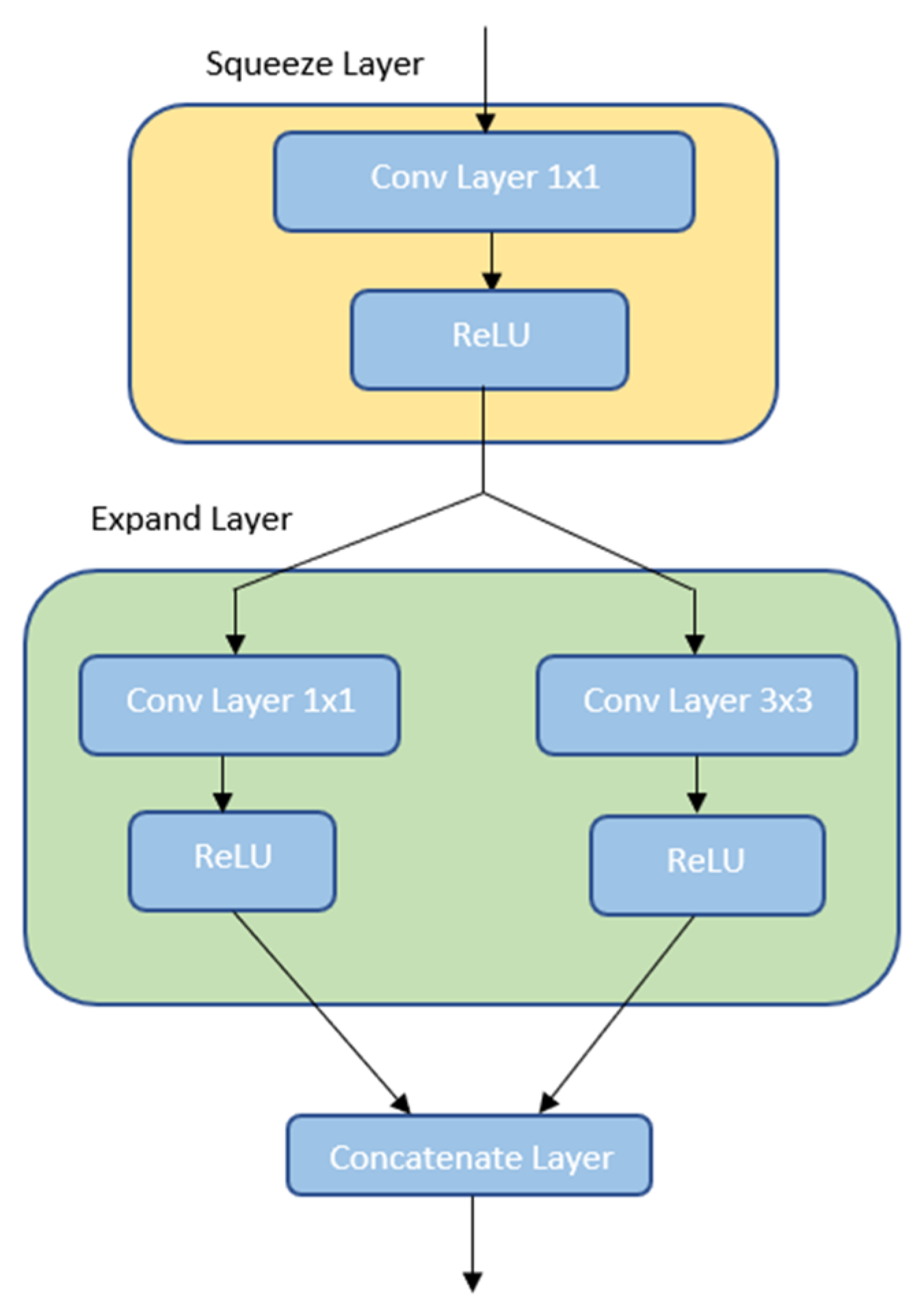

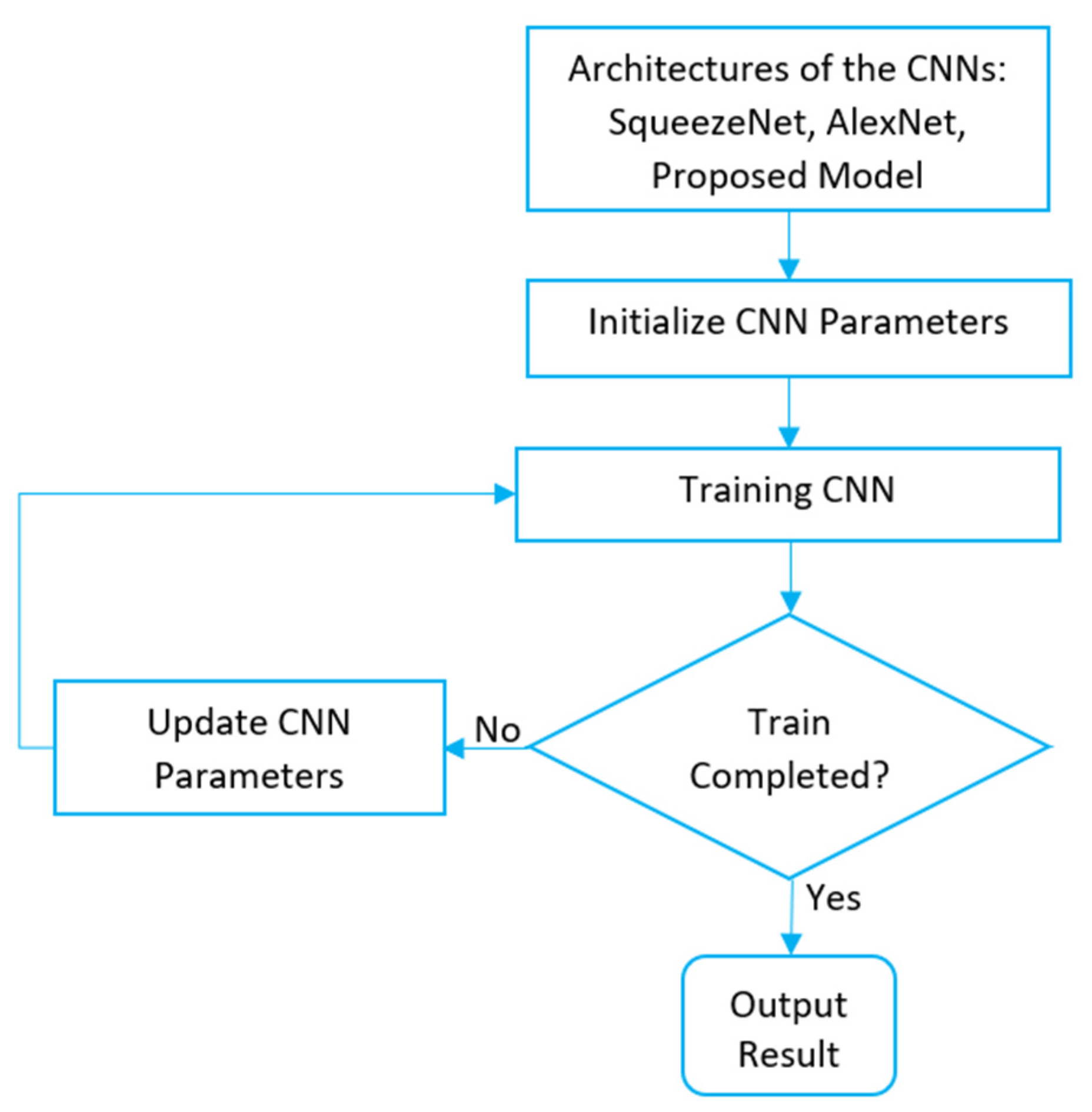
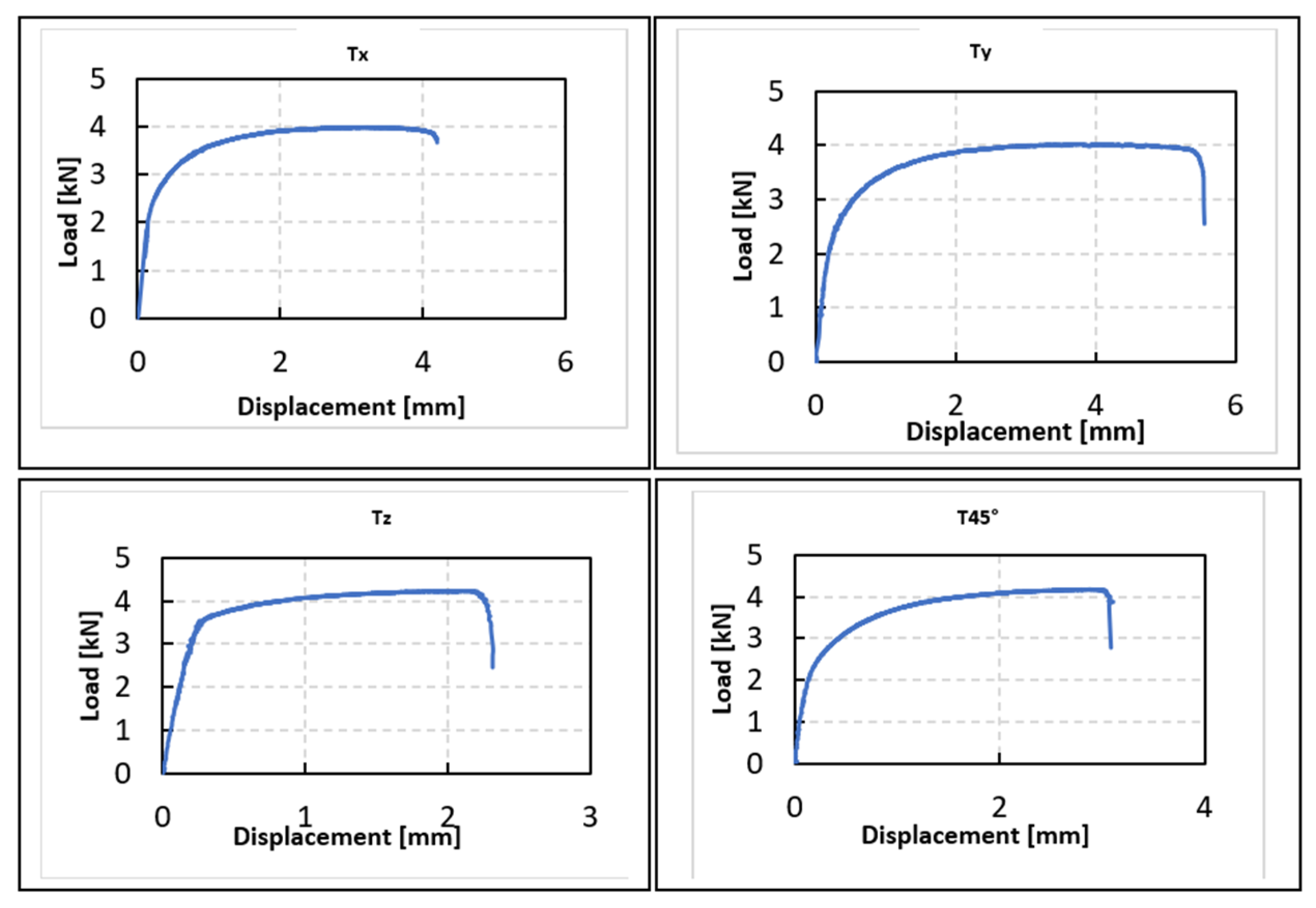
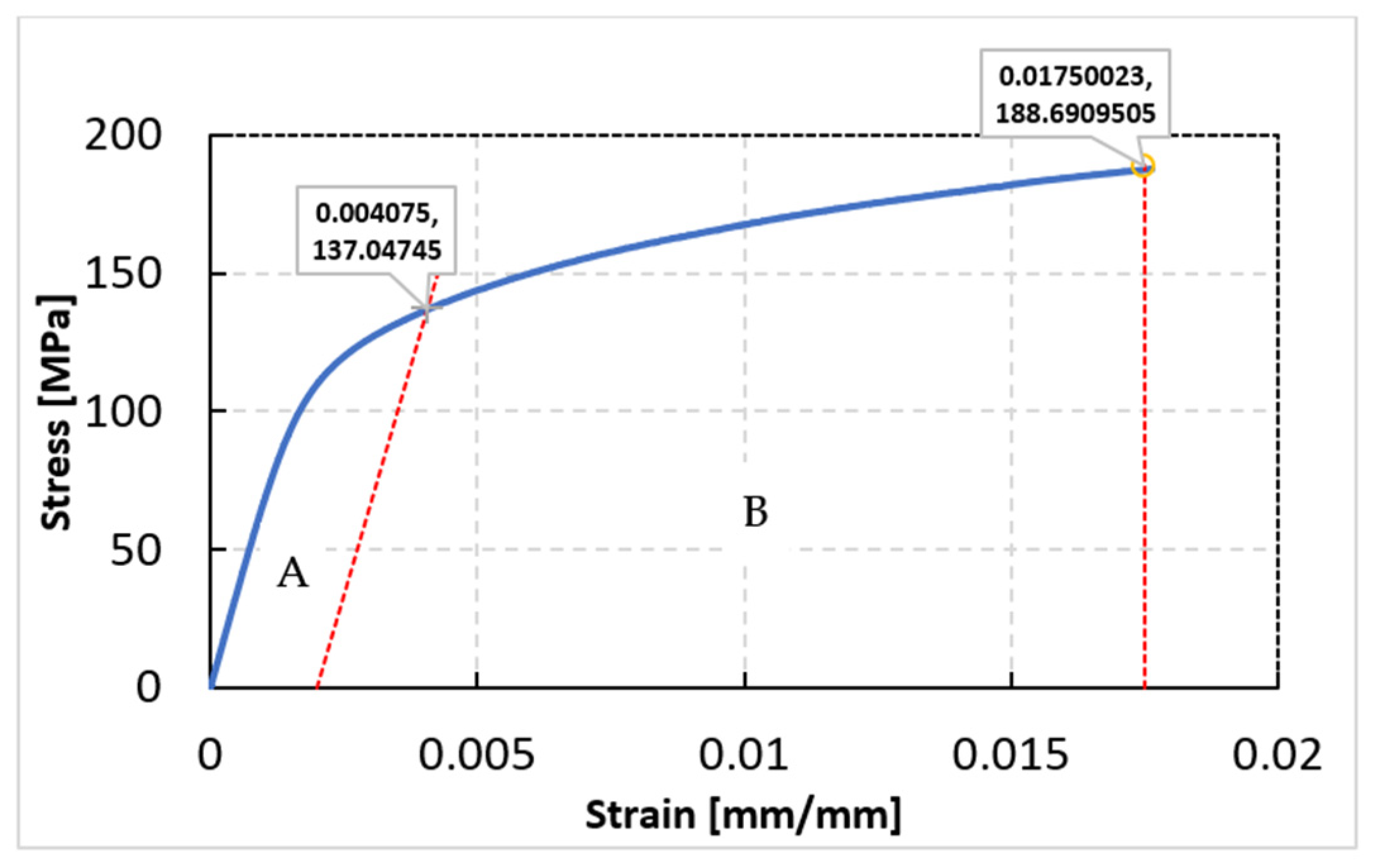

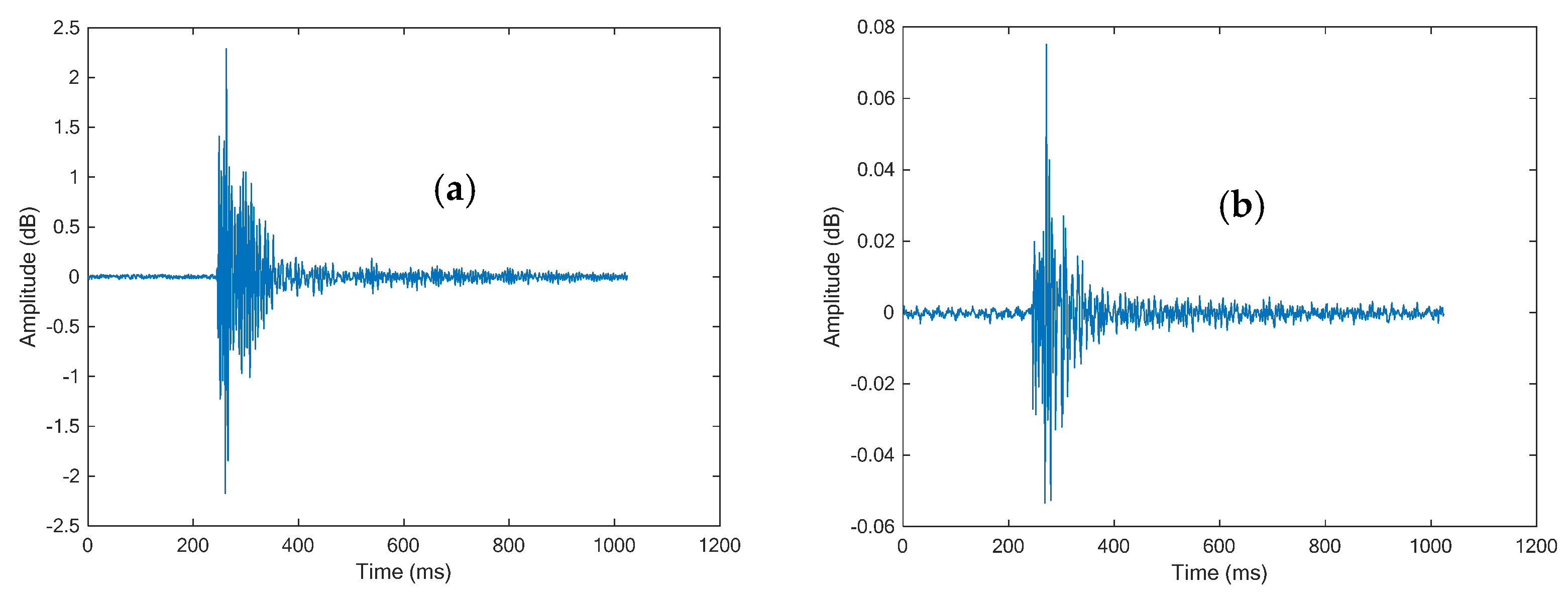
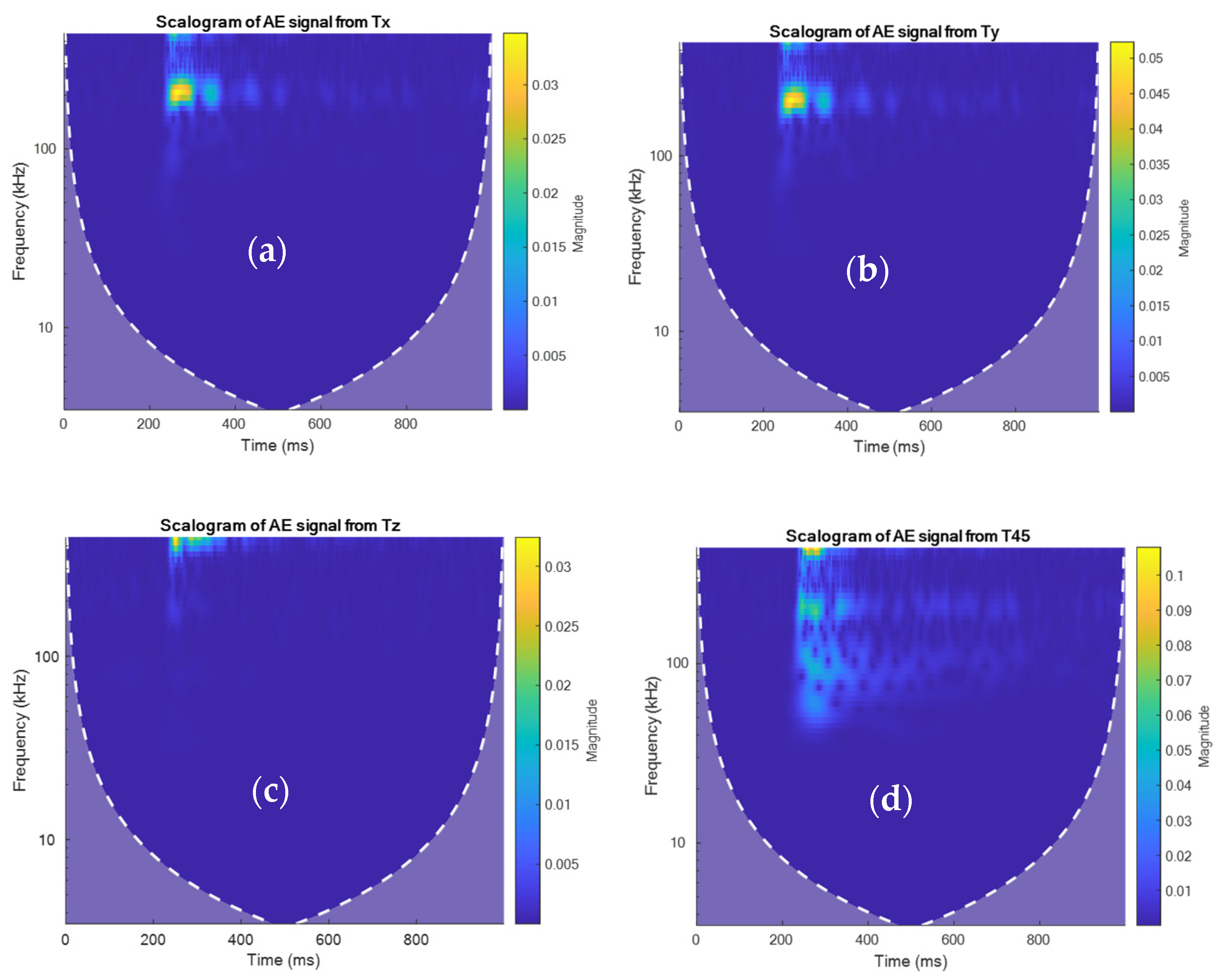


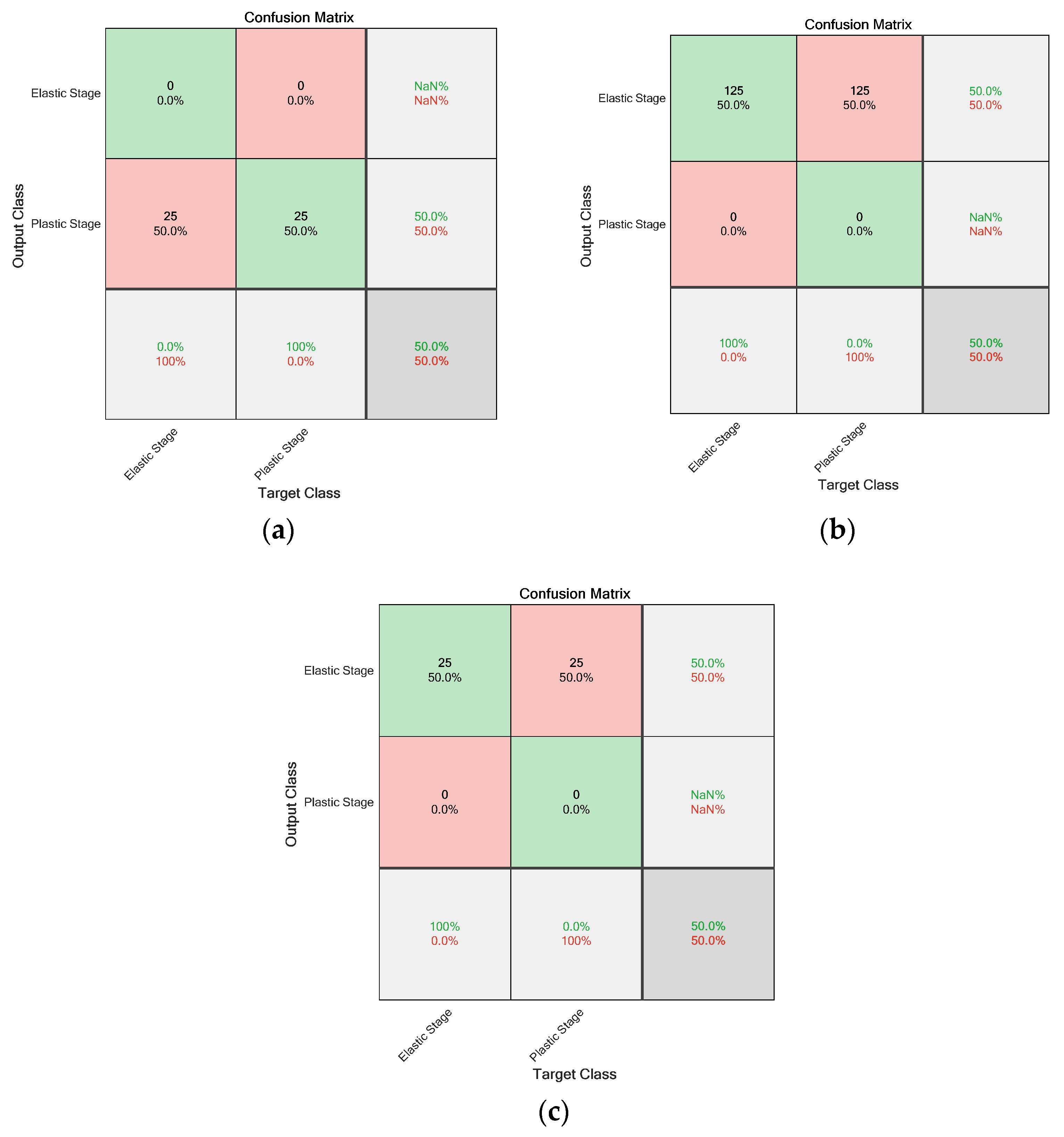

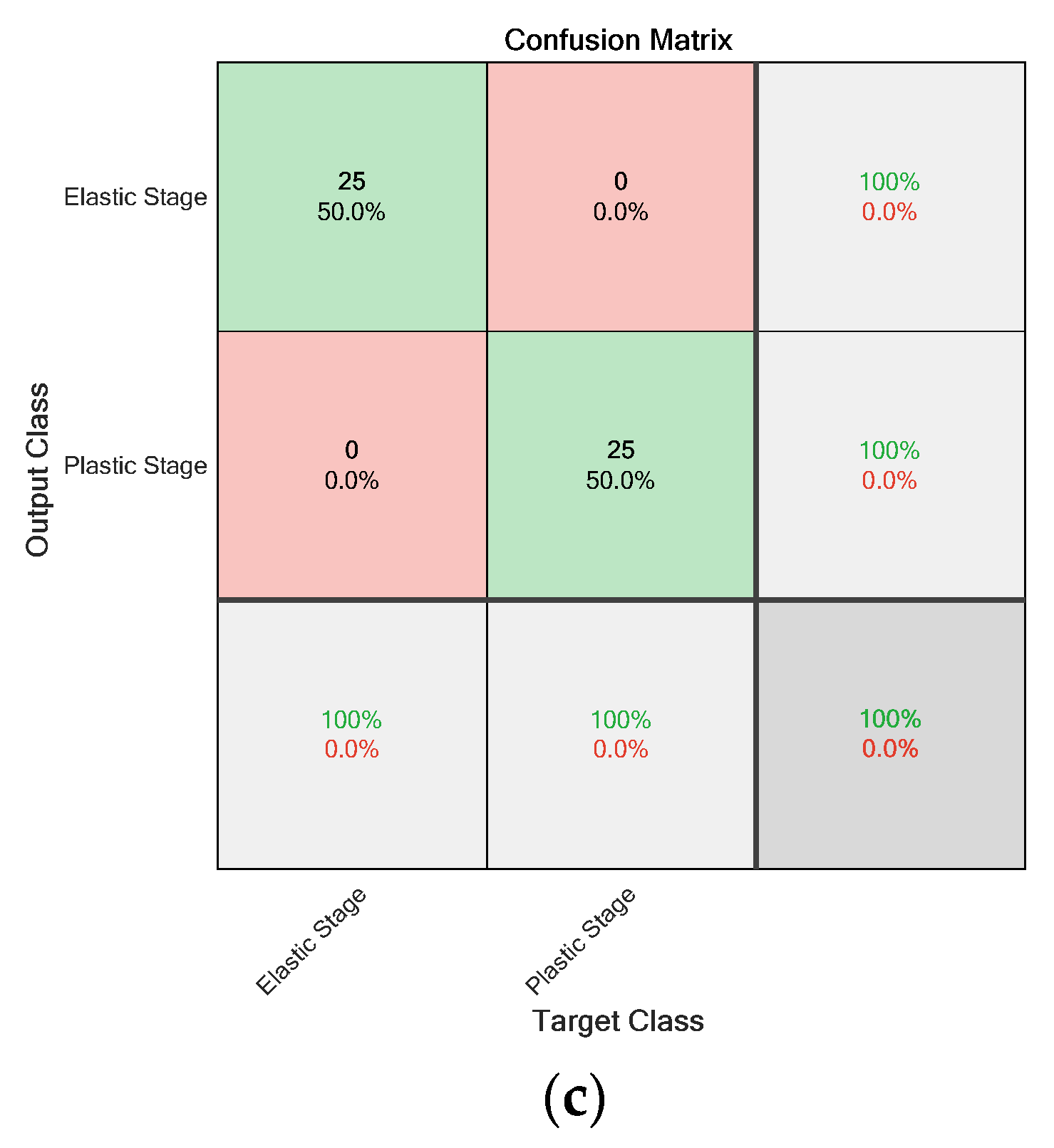

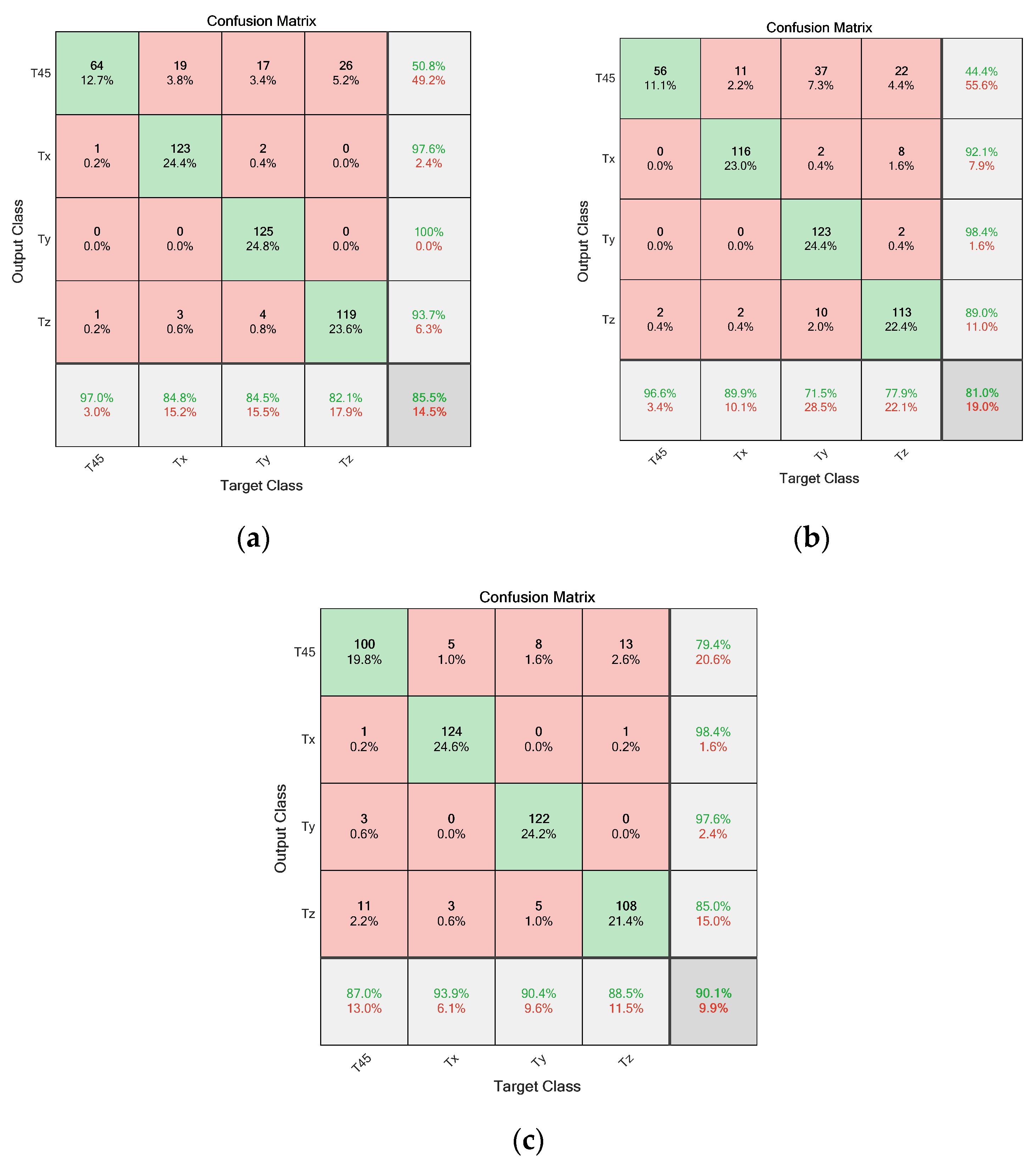
| Element | Mass (%) |
|---|---|
| AI | Bal a |
| Si | 11 |
| Mg | 0.45 |
| Fe | <0.25 |
| N | <0.2 |
| O | <0.2 |
| Ti | <0.15 |
| Zn | <0.1 |
| Mn | <0.1 |
| Ni | <0.05 |
| Layer | Description |
|---|---|
| Input Layer | 32 × 32 × 3 Spectrogram |
| Convolution 1, Pooling 1 | Convolution layer (Filter 3 × 3, 32 Filters) ReLu layer Max-pooling Layer (Filter 2 × 2, strides 2) |
| Convolution 2, Pooling 2 | Convolution layer (Filter 3 × 3, 64 Filter) ReLu layer Max-pooling Layer (Filter 2 × 2, strides 2) |
| Convolution 3, Pooling 3 | Convolution layer (Filter 3 × 3, 128 Filters) ReLu layer Max-pooling Layer (Filter 2 × 2, strides 2) |
| Convolution 4, Pooling 4 | Convolution layer (Filter 3 × 3, 256 Filters) ReLu layer Max-pooling Layer (Filter 2 × 2, strides 2) |
| Fully Connected Layer | Input Size: 4096 Output Size: 64 ReLu Activation |
| Fully Connected Layer | Input Size: 64 Output Size: 4 |
| SoftMax Layer | - |
| Classification Layer | - |
| Orientation | Metrics | Yield Strength MPa | Ultimate Tensile Strength MPa | Young’s Modulus E GPa | Elongation at Break % |
|---|---|---|---|---|---|
| Tx | Mean | 135.1 | 212.8 | 66.3 | 12.2 |
| Std_dev | 2.4 | 3.9 | 3.5 | 1.1 | |
| Ty | Mean | 138.8 | 215.4 | 68.4 | 12.7 |
| Std_dev | 2.7 | 2.2 | 3 | 4.6 | |
| Tz | Mean | 123.4 | 208.7 | 63.5 | 7.6 |
| Std_dev | 2.3 | 3.4 | 2.7 | 0.5 | |
| T45° | Mean | 125.2 | 212.8 | 64.3 | 9.6 |
| Std_dev | 2.4 | 2.5 | 1.3 | 1.4 |
| N° Training Mode [Tm] | Model | Number of Inputs | Type of Activation Function | Pooling Avg/Max | Validation [%] | Testing [%] | Times |
|---|---|---|---|---|---|---|---|
| TM 1 | AlexNet | 200 | Sigmoid | Avg/Max | 50 | 50 | 56 min 28 s |
| SqueezeNet | 200 | Sigmoid | Avg/Max | 50 | 50 | 46 min 04 s | |
| New Model | 200 | Sigmoid | Avg/Max | 50 | 50 | 26 min 46 s | |
| TM 2 | AlexNet | 200 | ReLu | Avg/Max | 100 | 100 | 40 min 27 s |
| SqueezeNet | 200 | ReLu | Avg/Max | 100 | 100 | 25 min 45 s | |
| New Model | 200 | ReLu | Avg/Max | 100 | 100 | 19 min 22 s | |
| TM 3 | AlexNet | 1000 | Sigmoid | Avg/Max | 50 | 50 | 3 h 29 min |
| SqueezeNet | 1000 | Sigmoid | Avg/Max | 48.7 | 50 | 2 h 57 min | |
| New Model | 1000 | Sigmoid | Avg/Max | 50 | 50 | 1 h 49 min | |
| TM 4 | AlexNet | 1000 | ReLu | Avg/Max | 100 | 100 | 2 h 07 min |
| SqueezeNet | 1000 | ReLu | Avg/Max | 100 | 100 | 1 h 16 min | |
| New Model | 1000 | ReLu | Avg/Max | 100 | 100 | 36 min 32 s |
| N° Training Mode [TM] | Model | Number of Inputs | Type of Activation Function | Pooling Avg/Max | Validation [%] | Testing [%] | Time |
|---|---|---|---|---|---|---|---|
| TM 1 | AlexNet | 300 | Sigmoid | Avg/Max | 33.3 | 33.3 | 1 h 9 min |
| SqueezeNet | 300 | Sigmoid | Avg/Max | 33.3 | 33.3 | 58 min 20 s | |
| New Model | 300 | Sigmoid | Avg/Max | 33.3 | 33.3 | 35 min 04 s | |
| TM 2 | AlexNet | 300 | ReLu | Avg/Max | 100 | 100 | 49 min 06 s |
| SqueezeNet | 300 | ReLu | Avg/Max | 100 | 100 | 38 min 07 s | |
| New Model | 300 | ReLu | Avg/Max | 100 | 100 | 24 min 00 s | |
| TM 3 | AlexNet | 1500 | Sigmoid | Avg/Max | 33.3 | 33.3 | 4 h 39 min |
| SqueezeNet | 1500 | Sigmoid | Avg/Max | 33.3 | 33.3 | 3 h 35 min | |
| New Model | 1500 | Sigmoid | Avg/Max | 33.3 | 33.3 | 2 h 01 min | |
| TM 4 | AlexNet | 1500 | ReLu | Avg/Max | 100 | 100 | 3 h 10 min |
| SqueezeNet | 1500 | ReLu | Avg/Max | 100 | 100 | 2 h 39 min | |
| New Model | 1500 | ReLu | Avg/Max | 100 | 100 | 1 h 40 s |
| N° Training Mode [TM] | Model | Number of Inputs | Type of Activation Function | Pooling Avg/Max | Validation [%] | Testing [%] | Time |
|---|---|---|---|---|---|---|---|
| TM 1 | AlexNet | 400 | ReLu | Avg/Max | 68.3 | 65 | 1 h 16 min |
| SqueezeNet | 400 | ReLu | Avg/Max | 61.7 | 62 | 55 min 01 s | |
| New Model | 400 | ReLu | Avg/Max | 69.7 | 68 | 40 min 05 s | |
| TM 2 | AlexNet | 2000 | ReLu | Avg/Max | 97.2 | 85.5 | 4 h 37 min |
| SqueezeNet | 2000 | ReLu | Avg/Max | 96.4 | 81 | 4 h 07 min | |
| New Model | 2000 | ReLu | Avg/Max | 97.8 | 90.1 | 2 h 50 min |
Disclaimer/Publisher’s Note: The statements, opinions and data contained in all publications are solely those of the individual author(s) and contributor(s) and not of MDPI and/or the editor(s). MDPI and/or the editor(s) disclaim responsibility for any injury to people or property resulting from any ideas, methods, instructions or products referred to in the content. |
© 2022 by the authors. Licensee MDPI, Basel, Switzerland. This article is an open access article distributed under the terms and conditions of the Creative Commons Attribution (CC BY) license (https://creativecommons.org/licenses/by/4.0/).
Share and Cite
Barile, C.; Casavola, C.; Pappalettera, G.; Kannan, V.P.; Mpoyi, D.K. Acoustic Emission and Deep Learning for the Classification of the Mechanical Behavior of AlSi10Mg AM-SLM Specimens. Appl. Sci. 2023, 13, 189. https://doi.org/10.3390/app13010189
Barile C, Casavola C, Pappalettera G, Kannan VP, Mpoyi DK. Acoustic Emission and Deep Learning for the Classification of the Mechanical Behavior of AlSi10Mg AM-SLM Specimens. Applied Sciences. 2023; 13(1):189. https://doi.org/10.3390/app13010189
Chicago/Turabian StyleBarile, Claudia, Caterina Casavola, Giovanni Pappalettera, Vimalathithan Paramsamy Kannan, and Dany Katamba Mpoyi. 2023. "Acoustic Emission and Deep Learning for the Classification of the Mechanical Behavior of AlSi10Mg AM-SLM Specimens" Applied Sciences 13, no. 1: 189. https://doi.org/10.3390/app13010189
APA StyleBarile, C., Casavola, C., Pappalettera, G., Kannan, V. P., & Mpoyi, D. K. (2023). Acoustic Emission and Deep Learning for the Classification of the Mechanical Behavior of AlSi10Mg AM-SLM Specimens. Applied Sciences, 13(1), 189. https://doi.org/10.3390/app13010189












